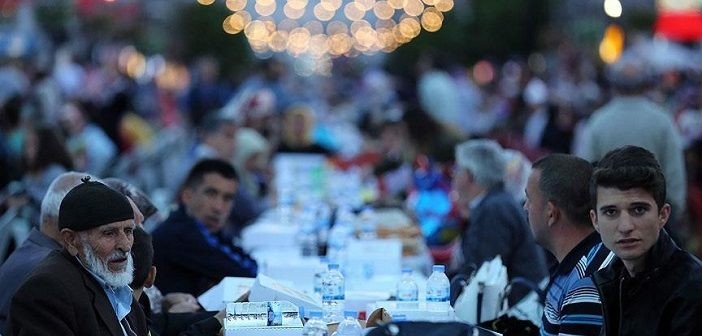
The Wajib Acts of Hajj (Shafii)
What are the obligatory pilgrimages of hajj? What are the obligatory things to perform during hajj in shafii?
Unless all essential acts of hajj are fulfilled, the hajj will be invalid. However, if the wajib (necessary) acts of hajj are not performed, the hajj will not be void, but it will be incomplete, which can be compensated by offering a sacrificial animal.
There are five wajib acts of hajj:
1. To enter the state of ihram in a place of miqat
It is necessary for the person who would like to perform hajj or umrah to enter the state of ihram in one of the places called miqat. One who passes the borders drawn by miqat places without entering the state of ihram will abandon one of the wajib (necessary) acts of hajj. Because of this, he is required to offer a sacrificial animal. However, if he returns to the place of miqat and enters the state of ihram before performing the tawaf al-umrah or tawaf al-qudum (arrival to Mecca), he does not have to offer a sacrificial animal.
They are the five places where pilgrims coming to Mecca should not pass without first entering the state of ihram.
- DHU AL-HULAIFA: It is the miqat place for people who are coming to Mecca from the direction of Medina. It is located 10km away from Medina. It is 430 km away from Mecca. It is the furthest miqat to Mecca. Our Prophet (pbuh) entered the state of ihram at this miqat place for his farewell pilgrimage (Hajj al-Wada’).
- JUHFA: It is the name of the miqat place for those coming from the direction of Egypt and Syria. It is 187km away from Mecca. People coming by way of the Red Sea through the Suez Channel wear ihram near Juhfa at a place called Rabigh.
- DHATU IRQ: It is the miqat place for those coming from the direction of lraq. Its distance from Mecca is 94km.
- QARNU MANAZIL: It is the miqat of those coming from the direction of Najid and Kuwait. It is 96 km from Mecca.
- YALAMLAM: It is the miqat of those coming from the direction of Yemen and India. It is 54 kms from Mecca.
2. To spend the night in Muzdalifa
Muzdalifa is a place located in the limits of Haram area between Mina and Arafat. After the sun sets, the pilgrims who perform waqfa in the Plain of Arafat leaves Arafat and arrives at Muzdalifa. It is wajib for the pilgrims to stay in Muzdalifa even if it is for a minute after midnight. It is a Sunnah to spend the entire night and set out to Mina after sunrise. It is recommended to collect small pebbles at night in Muzdalifa to stone the devil, to prolong staying in Muzdalifa by spending some time after Dawn Prayer until day breaks with remembrances of Allah, chanting talbiyas, takbirs, saying supplications, and repentances, and to perform staying (waqfa) in Muzdalifa close to the place called Mash’ar al-Haram.
3. To stone the devil (To stone the jamarat)
Stoning the devil means throwing small pebbles at three stone pillars called jamarat (Little Jamra, Middle Jamra, and Jamrat al-Aqaba) located in Mina. Stoning the devil is performed during the days of the festival.
On the first day of the festival, only the Jamrat al-Aqaba is stoned. Every single pebble is expected to be thrown into the pools surrounding the place of stoning the devil. It is a Sunnah to throw the seven pebbles consecutively and say “Bismillah! Allahu Akbar” when throwing each pebble. It is also a Sunnah to choose small pebbles to throw.
It is also recommended to say the following supplication when throwing the pebbles:
“O Allah! Accept my hajj, forgive my sins, and do not return my efforts unrequited. "
In addition to saying this supplication, one should also say takbirs in place of talbiya when throwing pebbles. This is because one should stop chanting talbiyas as soon as one begins to throw the first pebble.[1]
The time of stoning begins after midnight of the festival day after performing waqfa in Muzdalifa and continues until sunset on the same day. This is the optional time limits. It is also permissible to stone the jamarat after sunset.[2]
It is wajib to stone with seven pebbles first the Little Jamra, then the Middle Jamra, and finally Jamrat al-Aqaba on the second, third, and fourth days of the festival and to follow the abve-mentioned order when stoning. The seven pebbles should not be thrown all at once but rather one by one. If one does not follow the given order, jamarat should be stoned again in the given order. The jamarat are known amongst the public as the Little, Middle and Big Devils. The total number of pebbles thrown at jamarat reaches seventy.
The time for stoning the jamarat on the second, third, and the fourth days of the festival begins when the Noon Prayer time begins and continues until sunset. However, if one does not stone the jamarat during this time, it permissible for him to stone at night. If one does not stone the jamarat on one of the festival days, he may even do this on the next day and will not face penalty for doing this. A pilgrim who leaves Mina before the sunset on the third day of festival does not have to spend the night in Mina and stone the jamarat on the fourth day of the festival. This is an easiness bestowed by Allah Almighty upon the pilgrims who hastens to leave Mina. It is expressed in a verse as follows, “But if any one hastens to leave in two days, there is no blame on him, and if any one stays on, there is no blame on him, if his aim is to do right...”[3]
4. To spend the night in Mina
It is a Sunnah to spend the night before the first day of the festival in Mina to rest. However, it is wajib (necessary) to spend the nights of tashriq (festival) days in Mina. The pilgrim should spend most of the first and second nights of tashriq days in Mina. Provided that he leaves Mina before sunset on the third day, the requirement to spend the night in Mina drops and the next day he will not be required to stone the jamarat.
Staying in Mina during the nights of stoning the jamarat is wajib (necessary) upon those who do not have a legitimate excuse. For example, those who are in charge of distributing water to the pilgrims and those who are afraid for their lives if they stay in Mina will not face penalty when they do not take part in the stoning acts.
5. To perform tawaf al-wada
It is wajib for the pilgrim who fulfills the task of hajj or umrah and completes all the rites to perform tawaf al-wada’ with the intention to say farewell to the Ka’bah before leaving Mecca.
The pilgrim who performs tawaf al-wada should not stay in Mecca and hasten to leave. If a pilgrim keeps himself busy with things other than getting ready for the journey such as visiting a patient, he has to re-perform tawaf al-wada.
One who abandons tawaf al-wada has to offer a sacrificial animal. However, women who are menstruating or experiencing postpartum bleeding do not have to perform tawaf al-wada. It is reported that Abdullah b. Abbas (r.a.) said in this regard, “Menstruating woman may leave Mecca before performing tawaf al-wada, since Allah’s Messenger (pbuh) gave them the permission to leave (after Tawaf-Al-Ifada).”[4]
[1] Al-Shirbini, Mugni al-Muhtaj, 2/268
[2] Al-Shirbini, Mugni al-Muhtaj, 2/271
[3] Al-Baqara, 2: 203.
[4] Al-Bukhari, Hayd, 27, Hajj, 144; Muslim, Hajj, 380
Source: Fiqh1 (According To The Shafi’i School Of Islamic Law), Erkam Publications
The Definition of The Science of Fiqh (Shafii)
The Importance of The Science of Fiqh (Shafii)













